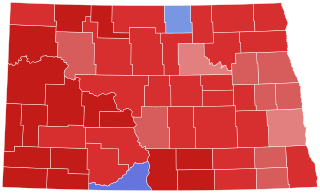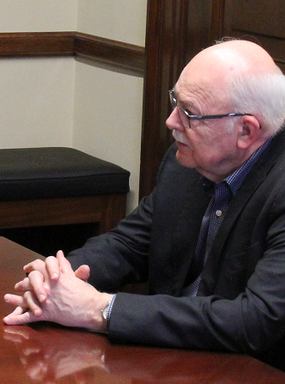
John Stewart Dalrymple III is an American politician and businessman who served as the 32nd governor of North Dakota from 2010 to 2016. A member of the Republican Party, he previously served as the 36th lieutenant governor of North Dakota from 2000 to 2010 under Governor John Hoeven.

The 2012 United States Senate election in North Dakota took place on November 6, 2012, concurrently with the 2012 U.S. presidential election, other United States Senate elections, United States House of Representatives elections, and various state and local elections. Incumbent Democratic-NPL Senator Kent Conrad decided to retire instead of running for reelection to a fifth term.

The 2008 North Dakota gubernatorial election took place on 4 November 2008 for the post of Governor of North Dakota. Incumbent Republican governor John Hoeven was easily reelected again, defeating Democratic-NPL challenger Tim Mathern. The primaries took place on June 10, 2008. John Hoeven outperformed John McCain, the Republican presidential nominee, by about 21%. McCain defeated Democratic nominee Barack Obama 53%–45% in the concurrent presidential election.

The 2008 United States presidential election in North Dakota took place on November 4, 2008, and was part of the 2008 United States presidential election. Voters chose three representatives, or electors to the Electoral College, who voted for president and vice president.

The 2010 United States Senate election in North Dakota took place on November 2, 2010, alongside other elections to the United States Senate in other states as well as elections to the United States House of Representatives and various state and local elections. Incumbent Democratic Senator Byron Dorgan announced in January 2010 that he would not seek reelection, leading to the first open seat election since 1992. Governor John Hoeven won the seat in a landslide, taking 76.1% of the vote, sweeping every county in the state, and becoming North Dakota's first Republican senator since 1987. Hoeven's 54 point margin of victory was a dramatic and historic shift from the previous election for this seat, when Dorgan won reelection in a 36-point landslide and himself swept every county in the state.

A general election was held in the U.S. state of North Dakota on Tuesday, November 2, 2010, with primary elections being held on June 8, 2010.

The 2012 United States House of Representatives election in North Dakota was held on Tuesday, November 6, 2012, to elect the U.S. representative from the state's at-large congressional district. The election coincided with the elections of other federal and state offices, including a quadrennial presidential election and an election to the U.S. Senate. A primary election was held on June 12, 2012; a candidate must receive at least 300 votes to appear on the general election ballot in November.

The 2012 United States presidential election in North Dakota took place on November 6, 2012, as part of the 2012 United States presidential election in which all 50 states plus the District of Columbia participated. North Dakota voters chose three electors to represent them in the Electoral College via a popular vote pitting incumbent Democratic President Barack Obama and his running mate, Vice President Joe Biden, against Republican challenger and former Massachusetts Governor Mitt Romney and his running mate, Congressman Paul Ryan.

The 2014 South Dakota gubernatorial election took place on November 4, 2014, to elect the Governor and Lieutenant Governor of South Dakota, concurrently with the election of South Dakota's Class II U.S. Senate seat, as well as other elections to the United States Senate in other states and elections to the United States House of Representatives and various state and local elections.
Lora Lyn Hubbel is an American politician; a former member of the South Dakota House of Representatives and a former chair of the Minnehaha County Republican Party and the former state chair of the Constitution Party of South Dakota.

A general election was held in the U.S. state of North Dakota on November 4, 2014. Five of North Dakota's executive officers were up for election as well as the state's at-large seat in the United States House of Representatives. Primary elections were held on June 10, 2014.

The 2016 North Dakota gubernatorial election was held on November 8, 2016, to elect the Governor and Lieutenant Governor of North Dakota, concurrently with the 2016 U.S. presidential election, as well as elections to the United States Senate, elections to the United States House of Representatives and various state and local elections. This would have been the first time North Dakotans selected a governor under new voter ID requirements, in which a student ID was insufficient identification to vote, but a court ruling in August 2016 struck the down the provision; the election was held under the 2013 rules.

Ricky Clark Becker is an American businessman and politician from Bismarck. He served in the North Dakota House of Representatives as a Republican from 2012 to 2022.

North Dakota held two statewide elections in 2016: a primary election on Tuesday, June 14, and a general election on Tuesday, November 8. In addition, each township elected officers on Tuesday, March 15, and each school district selected a date between April 1 and June 30 to hold their elections. This would have been the first election since the state legislature revoked the ability to use a student or military ID to satisfy state ID voting requirements, but a court ruling in August struck the down the provision, and the election was held under the 2013 rules.

The state of North Dakota held a series of elections on November 6, 2012. In addition to selecting presidential electors, North Dakotan voters selected one of its two United States Senators and its lone United States Representative, as well as seven statewide executive officers and one Supreme Court Justice. Primary elections were held on June 12, 2012.

The 2020 North Dakota gubernatorial election was held on November 3, 2020, to elect the governor and lieutenant governor of North Dakota, concurrently with other federal and statewide elections, including the U.S. presidential election. Incumbent Republican governor Doug Burgum and lieutenant governor Brent Sanford were both re-elected to a second term.

The 2018 North Dakota Secretary of State election occurred on November 6, 2018, to elect the North Dakota Secretary of State, concurrently with various other state and local elections. Six-time incumbent Republican Secretary of State Alvin Jaeger was eligible to run for re-election to a seventh term in office, but withdrew from his party's primary after failing to receive the endorsement. When the primary winner withdrew from the general election race, Jaeger and fellow Republican Michael Coachman each gathered and turned in signatures to run as independent candidates. Libertarian Party candidate Roland Riemers failed to get enough primary election votes to make the general election ballot both in an initial count and in a court-ordered recount. Democratic-NPL state representative Joshua Boschee was the only candidate who advanced from the primary and the only candidate that had his party listed on the general election ballot.

The 2020 United States House of Representatives election in North Dakota was held on November 3, 2020, to elect the U.S. representative from North Dakota's at-large congressional district. The election coincided with the 2020 U.S. presidential election, as well as other elections to the House of Representatives, elections to the United States Senate and various state and local elections.
Roland Clifford Riemers is an American perennial candidate best known for winning the 1996 North Dakota Democratic presidential primary.

The 2024 North Dakota gubernatorial election was held on November 5, 2024, to elect the governor of North Dakota. Incumbent Republican governor Doug Burgum decided to not seek re-election to a third term; he would ultimately decide to run for president. North Dakota is a Republican stronghold, and the Democratic–Nonpartisan League (NPL) Party has not won a governor's race in the state since 1988.


















